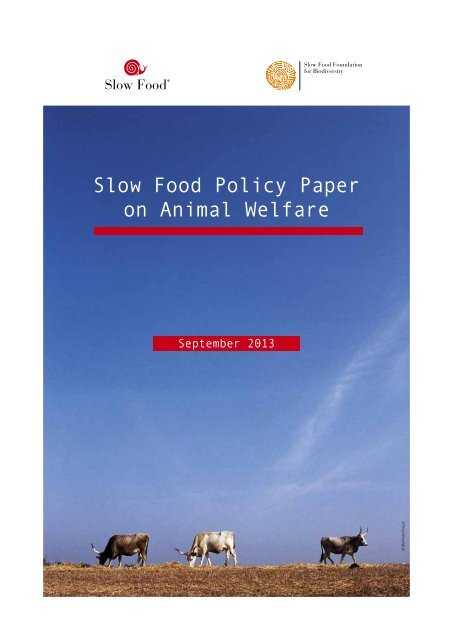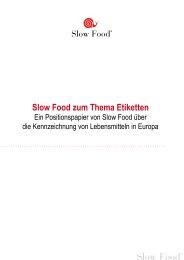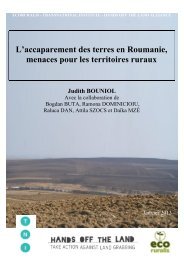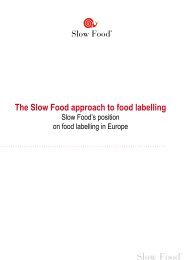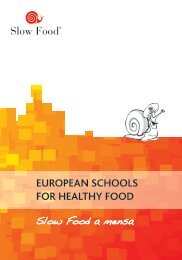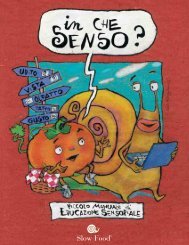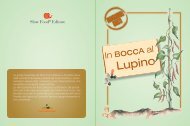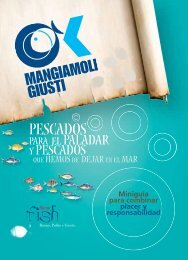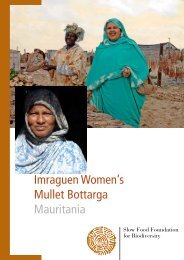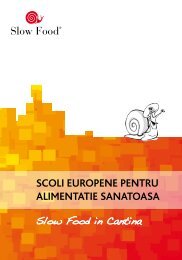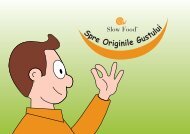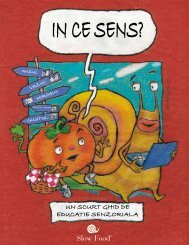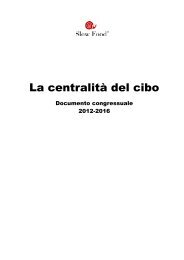Slow Food Policy Paper on Animal Welfare
Slow Food Policy Paper on Animal Welfare
Slow Food Policy Paper on Animal Welfare
You also want an ePaper? Increase the reach of your titles
YUMPU automatically turns print PDFs into web optimized ePapers that Google loves.
<str<strong>on</strong>g>Slow</str<strong>on</strong>g> <str<strong>on</strong>g>Food</str<strong>on</strong>g> <str<strong>on</strong>g>Policy</str<strong>on</strong>g> <str<strong>on</strong>g>Paper</str<strong>on</strong>g><br />
<strong>on</strong> <strong>Animal</strong> <strong>Welfare</strong><br />
September 2013<br />
© Manfredo Pinzauti
Written by<br />
Anne Marie Matarrese, PhD Candidate at the University of Leicester – Centre for <strong>Animal</strong>s and Social Justice www.casj.org.uk<br />
With input and editing from<br />
Cristina Agrillo, Daniela Battaglia, Elisa Bianco, Maurizio Busca, Silvia Ceriani, Rupert Ebner, Jacopo Ghi<strong>on</strong>e, Sim<strong>on</strong>e Gie,<br />
Silvio Greco, Serena Milano, Annamaria Pisapia, Raffaella P<strong>on</strong>zio, Paola Roveglia, Piero Sardo, Martina Tarantola.<br />
On the fr<strong>on</strong>t cover<br />
Maremmana Cattle – Photo by Manfredo Pinzauti<br />
The policy paper can be downloaded at the following link:<br />
www.slowfood.it/slowcheese/eng/20/animal-welfare<br />
For further informati<strong>on</strong>:<br />
animalwelfare@slowfood.it<br />
The sole resp<strong>on</strong>sibility of this publicati<strong>on</strong> lies with the author.<br />
The European Uni<strong>on</strong> is not resp<strong>on</strong>sible for any use that may be made of the informati<strong>on</strong> c<strong>on</strong>tained therein.<br />
2
<strong>Animal</strong> <strong>Welfare</strong> According to <str<strong>on</strong>g>Slow</str<strong>on</strong>g> <str<strong>on</strong>g>Food</str<strong>on</strong>g><br />
Each year the welfare of milli<strong>on</strong>s of animals raised for their meat, milk and eggs for human c<strong>on</strong>sumpti<strong>on</strong> is often seriously<br />
compromised. Intensive livestock producti<strong>on</strong> also significantly jeopardizes envir<strong>on</strong>mental sustainability, human health and<br />
the livelihood of small-scale farmers and rural communities. As the c<strong>on</strong>sumpti<strong>on</strong> of animal products c<strong>on</strong>tinues to increase,<br />
it has become necessary to c<strong>on</strong>fr<strong>on</strong>t these problems in order to safeguard the health of citizens and the envir<strong>on</strong>ment, and<br />
guarantee that small-scale farmers can thrive in their activities while ensuring that the welfare of animals is respected.<br />
Calabrian Podolica Cattle, Italy<br />
© <str<strong>on</strong>g>Slow</str<strong>on</strong>g> <str<strong>on</strong>g>Food</str<strong>on</strong>g> Archives<br />
<strong>Animal</strong> <strong>Welfare</strong> and Small-Scale Farmers<br />
FAO data indicates that around 1 billi<strong>on</strong> people depend <strong>on</strong> animals as a source of income, food, cultural identity and social<br />
status. It is estimated that 60% of families that live in rural areas keep animals 1 . <strong>Animal</strong> welfare is of crucial importance<br />
to these communities in that a secure supply of food depends <strong>on</strong> the health and productivity of animals, and these in turn<br />
depend <strong>on</strong> the care and nutriti<strong>on</strong> that animals receive. Good living c<strong>on</strong>diti<strong>on</strong>s for animals means better animal health, less<br />
stress and subsequently less disease and use of drugs. While structural investments for the improvement of producti<strong>on</strong><br />
facilities in the short term can be very costly for producers, the benefits in productivity and in improved product quality can<br />
increase income.<br />
The current system poses a great threat to the livelihood of small-scale farmers who cannot keep up with the competiti<strong>on</strong><br />
of big producers and the low prices of industrial meat producti<strong>on</strong>. The lack of a proper labelling system makes it more<br />
complicated for c<strong>on</strong>sumers to make c<strong>on</strong>scious choices and thus more difficult to ‘reward’ farmers that employ more<br />
animal-welfare friendly techniques. Knowing the story behind the animal products we eat should not be c<strong>on</strong>sidered<br />
important solely from a gastr<strong>on</strong>omic standpoint, but should be a duty of all resp<strong>on</strong>sible c<strong>on</strong>sumers, as it is a choice that<br />
determines the survival of small-scale farmers and the c<strong>on</strong>diti<strong>on</strong>s in which animals are raised.<br />
Low quality meat at an excessively high cost<br />
Over the past fifty years, agriculture has been subjected to increasing industrialisati<strong>on</strong>, al<strong>on</strong>g with a corresp<strong>on</strong>ding rise in<br />
meat c<strong>on</strong>sumpti<strong>on</strong>. These changes have come at a high cost for the envir<strong>on</strong>ment. According to the FAO, around 280 milli<strong>on</strong><br />
t<strong>on</strong>nes of meat are produced every year 2 . Every American c<strong>on</strong>sumes around 125kg of meat a year, while the European<br />
average is 74kg. Demand has been increasing globally even in many developing countries and emerging ec<strong>on</strong>omies over<br />
the past ten years, due to a growth in wealth in the urban middle classes. Figures <strong>on</strong> meat c<strong>on</strong>sumpti<strong>on</strong> in China are<br />
particularly striking, with c<strong>on</strong>sumpti<strong>on</strong> rising from around 20kg per pers<strong>on</strong> in 1980 to 52 kg in 2006. 3<br />
The repercussi<strong>on</strong>s of such patterns of c<strong>on</strong>sumpti<strong>on</strong> are devastating: CO 2<br />
emissi<strong>on</strong>s from the world meat producti<strong>on</strong> and<br />
distributi<strong>on</strong> cycle are estimated between 18% and 51% of global emissi<strong>on</strong>s 4 . Current practices also heavily c<strong>on</strong>tribute<br />
to soil degradati<strong>on</strong>, increasing desertificati<strong>on</strong>, polluti<strong>on</strong>, reducti<strong>on</strong> of water resources and the loss of plant and animal<br />
1 FAO (2009) The State of <str<strong>on</strong>g>Food</str<strong>on</strong>g> and Agriculture – http://bit.ly/anwmnC<br />
World Livestock – Livestock in <str<strong>on</strong>g>Food</str<strong>on</strong>g> Security (2011) – http://bit.ly/vRlZBC<br />
2 FAO (2008) <str<strong>on</strong>g>Food</str<strong>on</strong>g> Outlook – November Editi<strong>on</strong> http://bit.ly/1aH5PXb<br />
3 FAO (2006) Livestock’s L<strong>on</strong>g Shadow http://bit.ly/CRCLd<br />
3
iodiversity. A reducti<strong>on</strong> in the c<strong>on</strong>sumpti<strong>on</strong> of meat is the first step to countering these problems, but choosing animal<br />
products that have been produced with high welfare standards can c<strong>on</strong>tribute to a healthier envir<strong>on</strong>ment.<br />
© Alberto Peroli<br />
Cows grazing in Ciminà, Calabria, Italy<br />
An Unsustainable System<br />
The intensive producti<strong>on</strong> of meat requires vast amounts of land to allow space for grazing and the producti<strong>on</strong> of animal<br />
feed. Around 3,5 billi<strong>on</strong> hectares of land (making up 26% of total dry land) 5 are involved in meat producti<strong>on</strong>. Around 470<br />
milli<strong>on</strong> hectares al<strong>on</strong>e are devoted to the producti<strong>on</strong> of animal feed, adding up to a third of arable land 6 . <strong>Animal</strong> feed<br />
used in Europe is mostly imported, with an average of 40 milli<strong>on</strong> t<strong>on</strong>nes of protein crops imported annually from South<br />
American countries, mainly in the form of soy beans and corn gluten feed 7 . The intensive producti<strong>on</strong> of animal feed has<br />
devastating impacts <strong>on</strong> the envir<strong>on</strong>ment. It is estimated that cattle raising is resp<strong>on</strong>sible for about 80% of all deforestati<strong>on</strong><br />
in the Amaz<strong>on</strong> regi<strong>on</strong> 8 .<br />
Furthermore, while being the world’s largest importer of animal feed, Europe is also a large-scale exporter of meat and dairy<br />
products in developing countries, competing with local producers and threatening the development of local ec<strong>on</strong>omies and<br />
livelihood of communities.<br />
The questi<strong>on</strong> of animal feed, however, also goes well bey<strong>on</strong>d the farm, affecting all those countries that produce raw<br />
materials for the feed that is then used for livestock in western countries. Maize and soy m<strong>on</strong>ocultures are severely<br />
influencing the development of local communities and the ecological balance of the planet.<br />
Industrial Farming and <strong>Animal</strong> Suffering<br />
4 World Watch Institute (2009) Livestock and Climate Change – http://bit.ly/2mKHdI<br />
5 FAO (2006) Livestock’s L<strong>on</strong>g Shadow – http://bit.ly/CRCLd<br />
6 Ibidem<br />
7 Friends of the Earth (2010) Less Soy, More Legumes – http://bit.ly/1eWfvlr<br />
8 Greenpeace (2009) Slaughtering the Amaz<strong>on</strong> – http://bit.ly/f2IDmb<br />
To learn more, see also the short video http://bit.ly/19TE10L and photogallery<br />
http://bit.ly/KoXTRT by Greenpeace.<br />
4
In 2007, the Treaty of Lisb<strong>on</strong> of the European Uni<strong>on</strong> officially recognized animals as sentient beings and stated that Member<br />
States must pay full regard to animal welfare in decisi<strong>on</strong> making, thereby putting animal welfare <strong>on</strong> equal footing with<br />
other key principles such as gender equality, social protecti<strong>on</strong>, the protecti<strong>on</strong> of human health, sustainable development<br />
and c<strong>on</strong>sumer protecti<strong>on</strong> 9 . Despite this important move, too often the welfare of farmed animals is still neglected.<br />
<strong>Animal</strong>s pay a harsh price in the current system. Factory farms reduce animals to mere machines and commodities. They<br />
are packed into tight cages or c<strong>on</strong>fined to small spaces where they spend a short but painful life. During this time they<br />
are often subjected to mutilati<strong>on</strong>s, their beaks are trimmed, tails docked and horns removed in order to avoid injuring<br />
themselves or their compani<strong>on</strong>s due to the stresses of being c<strong>on</strong>demned to a life less than natural. After having spent the<br />
entirety of their lives in these c<strong>on</strong>diti<strong>on</strong>s, they are then transported to slaughterhouses, often travelling for many hours at<br />
a time and in gruelling c<strong>on</strong>diti<strong>on</strong>s. They feel the stresses and strains of not being able to express their natural behaviours,<br />
often left in the hands of people who have not received adequate training, denying them the compassi<strong>on</strong>ate and respectful<br />
treatment that a sentient being deserves 10 . Living in these c<strong>on</strong>diti<strong>on</strong>s makes animals more pr<strong>on</strong>e to diseases. In many<br />
intensive farms they are therefore routinely injected with vaccines and antibiotics, posing a risk to those who c<strong>on</strong>sume<br />
their meat. In the US for instance, 80% of all antibiotics used is destined to the livestock sector 11 and in Germany data<br />
indicates that an estimated 1700 metric t<strong>on</strong>nes of antibiotics are employed for veterinary use compared to about 300<br />
metric t<strong>on</strong>nes for humans use 12 .<br />
© Valeria Necchio<br />
Salers Cattle, France<br />
Knowing Where Your <str<strong>on</strong>g>Food</str<strong>on</strong>g> Comes From<br />
<strong>Animal</strong> welfare has become an increasingly important issue for c<strong>on</strong>sumers: they want to know where their food comes<br />
from, ensure that it is safe and has been produced according to high standards. <str<strong>on</strong>g>Slow</str<strong>on</strong>g> <str<strong>on</strong>g>Food</str<strong>on</strong>g> members are particularly<br />
attentive when it comes to food choices. A recent survey c<strong>on</strong>ducted am<strong>on</strong>gst European <str<strong>on</strong>g>Slow</str<strong>on</strong>g> <str<strong>on</strong>g>Food</str<strong>on</strong>g> members further<br />
c<strong>on</strong>firmed their awareness when it comes to meat c<strong>on</strong>sumpti<strong>on</strong> and animal welfare. In fact, 87% of resp<strong>on</strong>dents said they<br />
were willing to change their shopping habits to buy more animal welfare friendly foods, compared to 62% of c<strong>on</strong>sumers<br />
in a similar survey by the European Commissi<strong>on</strong> 13 . Furthermore, 90% of European <str<strong>on</strong>g>Slow</str<strong>on</strong>g> <str<strong>on</strong>g>Food</str<strong>on</strong>g> members that took part in<br />
the survey indicated that they were willing to pay a higher price for products that guarantee high welfare standards. The<br />
same percentage also believes their purchasing choices can positively impact animal welfare. In order to allow c<strong>on</strong>sumers<br />
to make these informed decisi<strong>on</strong>s and ensure farmers who invest in animal welfare are supported, mandatory adequate<br />
labelling of animal products, which currently does not exist, must be guaranteed.<br />
9 The Treaty of Lisb<strong>on</strong> http://bit.ly/Gzwfkn<br />
10 To learn more about the role of factory farming <strong>on</strong> animal suffering, see The Way We Eat. Why Our <str<strong>on</strong>g>Food</str<strong>on</strong>g> Choices Matter, by Peter Singer and Jim Mas<strong>on</strong> (2006,<br />
R<strong>on</strong>dale Books) and J<strong>on</strong>athan Safran Foer’s Eating <strong>Animal</strong>s (2010, Black Bay Books)<br />
11 Centers for Disease C<strong>on</strong>trol and Preventi<strong>on</strong> (2013) Threat Report 2013 – http://1.usa.gov/1eH9sSL<br />
12 Bundesamt für Verbraucherschutz und Lebensmittelsicherheit (2013): Hintergrundinformati<strong>on</strong>: Zahlen über die Antibiotikaabgabe 2011 in der Tiermedizin nach<br />
Regi<strong>on</strong>en und Wirkstoffklassen http://bit.ly/1fxeOPO<br />
13 European Commissi<strong>on</strong> (2006) Attitudes of EU Citizens towards <strong>Animal</strong> <strong>Welfare</strong> – http://bit.ly/nHctNf<br />
5
<strong>Animal</strong>-<strong>Welfare</strong> Policies in the EU: Where Are We Now and Where Are We Heading?<br />
Since the early 1990’s, the European Uni<strong>on</strong> has been <strong>on</strong> the forefr<strong>on</strong>t c<strong>on</strong>cerning animal welfare legislati<strong>on</strong>. Much has<br />
been achieved over the years: Barren battery cages for hens have been outlawed, as have sow stalls (after the first few<br />
weeks of pregnancy) and the tethering of sows and veal crates. However, much still remains to be d<strong>on</strong>e and at the heart<br />
of the problem lay issues of enforcement and implementati<strong>on</strong>.<br />
The European Uni<strong>on</strong>’s sec<strong>on</strong>d Strategy for the Protecti<strong>on</strong> and <strong>Welfare</strong> of <strong>Animal</strong>s was welcomed in 2012 and outlines the<br />
EU’s visi<strong>on</strong> for animal welfare until 2015. While the document outlines that the EU is committed to the issue, many areas<br />
were not addressed and a serious legislative void exists in many cases:<br />
► <strong>Animal</strong> transport: legislati<strong>on</strong> currently allows animals to be transported for several days. While animal advocacy<br />
groups are working to set a limit at eight hours, for <str<strong>on</strong>g>Slow</str<strong>on</strong>g> <str<strong>on</strong>g>Food</str<strong>on</strong>g> this is still an unacceptably l<strong>on</strong>g transport time.<br />
► Dairy cows: no law regulating the well-being of cows used in the dairy industry currently exists.<br />
► Antibiotics: a strategy for the substantial reducti<strong>on</strong> of the use of antibiotics in animal husbandry is needed.<br />
► Cl<strong>on</strong>ed <strong>Animal</strong>s: a clear ban <strong>on</strong> the sale of meat from cl<strong>on</strong>es and their offspring is yet to be put in place.<br />
► Labelling: no labelling system for meat products exists, making animal-welfare friendly choices difficult for c<strong>on</strong>sumers<br />
and leaving them further in the dark as to whether animals are fed with GM feed.<br />
Other areas of c<strong>on</strong>cern include the loss of local slaughterhouses meaning that even small-scale farmers must transport<br />
their animals for l<strong>on</strong>g distances. This causes the animals to be stressed before and during the slaughter process and causes<br />
the quality of the meat to be compromised, resulting in a loss in terms of productivity. To counter this problem, more local<br />
and smaller slaughterhouses are needed and initiatives and legislati<strong>on</strong> addressing the use of mobile slaughterhouses must<br />
be promoted.<br />
Implementati<strong>on</strong> is a further issue of c<strong>on</strong>cern within European countries. In 2012 the law banning battery cages was<br />
introduced and despite having 12 years to comply with the legislati<strong>on</strong>, many countries failed to do so, resulting in a<br />
situati<strong>on</strong> of c<strong>on</strong>tinuing suffering for hens relegated to overcrowded cages. The same situati<strong>on</strong> repeated itself when the<br />
2013 ban <strong>on</strong> sow stalls was introduced. Member States must ensure effective m<strong>on</strong>itoring and c<strong>on</strong>trols regarding animal<br />
welfare legislati<strong>on</strong> in order to ensure maximum compliance and avoid the suffering of animals.<br />
In the 2012-2015 Strategy, the European Uni<strong>on</strong> indicated that it will pursue research <strong>on</strong> the welfare of fish. Increasing<br />
amounts of research indicate that fish are intelligent creatures, capable of feeling pain, fear and psychological stress 14 . Fish<br />
are being threatened by the exploitati<strong>on</strong> of the marine envir<strong>on</strong>ment and the devastating c<strong>on</strong>sequences of aquaculture. This<br />
has serious implicati<strong>on</strong>s for the livelihood of local communities around the world that have depended <strong>on</strong> fishing for many<br />
generati<strong>on</strong>s. Farmed fish are c<strong>on</strong>fined in very small areas and poor quality water and overcrowded spaces mean that they<br />
cannot breathe properly. Furthermore, c<strong>on</strong>fining fish to cages means that they cannot exercise their natural swimming<br />
behaviour. The welfare and the sustainability of farmed fish should therefore be an area of c<strong>on</strong>cern.<br />
© Giuseppe Fassino<br />
Saluzzo Hen, Piedm<strong>on</strong>t, Italy<br />
14 To learn more, see J<strong>on</strong>athan Safran Foer’s book Eating <strong>Animal</strong>s (2010, Black Bay Books) who discusses the suffering experienced by salm<strong>on</strong> in intensive fish farms.<br />
6
<str<strong>on</strong>g>Slow</str<strong>on</strong>g> <str<strong>on</strong>g>Food</str<strong>on</strong>g> is c<strong>on</strong>vinced that a greater coherence <strong>on</strong> food policies at the EU level is needed and, in this respect, hopes<br />
that the Comm<strong>on</strong> Agricultural <str<strong>on</strong>g>Policy</str<strong>on</strong>g> measures <strong>on</strong> animal welfare will provide real support to farmers. In particular, it<br />
is necessary to introduce measures that take into c<strong>on</strong>siderati<strong>on</strong> the cost of animal welfare by supporting farmers who<br />
voluntary choose to improve their standards bey<strong>on</strong>d those required by law. <str<strong>on</strong>g>Slow</str<strong>on</strong>g> <str<strong>on</strong>g>Food</str<strong>on</strong>g> will furthermore strive for the full<br />
recogniti<strong>on</strong> of animal welfare as an element in future EU strategies <strong>on</strong> the sustainability of the food system.<br />
The <str<strong>on</strong>g>Slow</str<strong>on</strong>g> <str<strong>on</strong>g>Food</str<strong>on</strong>g> Approach to <strong>Animal</strong> <strong>Welfare</strong><br />
<str<strong>on</strong>g>Slow</str<strong>on</strong>g> <str<strong>on</strong>g>Food</str<strong>on</strong>g> has been actively working to promote a holistic approach to food and agriculture for many years and good<br />
animal welfare practices are a fundamental part of this. They are important not <strong>on</strong>ly because they respect animals as<br />
sentient beings, but also because they benefit farmers, c<strong>on</strong>sumers and the envir<strong>on</strong>ment.<br />
<str<strong>on</strong>g>Slow</str<strong>on</strong>g> <str<strong>on</strong>g>Food</str<strong>on</strong>g>’s survey <strong>on</strong> meat c<strong>on</strong>sumpti<strong>on</strong> and animal welfare indicated that 89% of resp<strong>on</strong>dents believe that animal<br />
welfare does not receive enough attenti<strong>on</strong> in their country’s policies. Members also called for <str<strong>on</strong>g>Slow</str<strong>on</strong>g> <str<strong>on</strong>g>Food</str<strong>on</strong>g> to take acti<strong>on</strong> by<br />
raising awareness am<strong>on</strong>g public authorities and supporting producers who work to better the c<strong>on</strong>diti<strong>on</strong> of their animals.<br />
Through its projects <str<strong>on</strong>g>Slow</str<strong>on</strong>g> <str<strong>on</strong>g>Food</str<strong>on</strong>g> can ensure that the c<strong>on</strong>necti<strong>on</strong> between animal welfare, human health and livelihoods, and<br />
envir<strong>on</strong>mental sustainability is understood by a growing number of people. In particular, with projects such as the Presidia,<br />
<str<strong>on</strong>g>Slow</str<strong>on</strong>g> <str<strong>on</strong>g>Food</str<strong>on</strong>g> can have a direct impact <strong>on</strong> the welfare of animals. <str<strong>on</strong>g>Slow</str<strong>on</strong>g> <str<strong>on</strong>g>Food</str<strong>on</strong>g> will therefore begin an important journey in the<br />
elaborati<strong>on</strong> of specific guidelines <strong>on</strong> animal welfare, involving the producers themselves as well as members of the Terra<br />
Madre food communities.<br />
Current <str<strong>on</strong>g>Slow</str<strong>on</strong>g> <str<strong>on</strong>g>Food</str<strong>on</strong>g> Presidia producti<strong>on</strong> protocols involving livestock already include a variety of welfare provisi<strong>on</strong>s. Protocols<br />
state that Presidia must safeguard native breeds or breeds that have adapted to the local envir<strong>on</strong>ment. Producers are<br />
required to pay particular attenti<strong>on</strong> to the bedding and the amount of space available for each animal, guarantee access to<br />
pastures where possible or space for animals to roam freely. It is important in the Presidia that reproducti<strong>on</strong> occurs within<br />
the farm itself and that newborns are allowed to spend as much time as possible next to their mothers. Diets are based<br />
<strong>on</strong> fresh forage which can be integrated, when necessary, with hay, cereals and legumes, preferably locally produced.<br />
Therapeutic interventi<strong>on</strong>s must prioritize the use of plant-based or homeopathic remedies, while antibiotics and other<br />
c<strong>on</strong>venti<strong>on</strong>al veterinary medicines must be used <strong>on</strong>ly if other effective remedies for the ailment do not exist.<br />
<str<strong>on</strong>g>Slow</str<strong>on</strong>g> <str<strong>on</strong>g>Food</str<strong>on</strong>g> does not support practices involving the close c<strong>on</strong>finement of livestock, the use of genetically modified animals<br />
or their offspring, l<strong>on</strong>g distance transport, routine mutilati<strong>on</strong>s, the use of antibiotics, and slaughter without pre-stunning.<br />
<strong>Animal</strong> feed must not include the use of urea, corn silage, foods or products made even partly with genetically modified<br />
organisms, additives and industrial waste.<br />
© Archivio <str<strong>on</strong>g>Slow</str<strong>on</strong>g> <str<strong>on</strong>g>Food</str<strong>on</strong>g><br />
Texel Sheep, Netherlands<br />
© FIAF<br />
7
<str<strong>on</strong>g>Slow</str<strong>on</strong>g> <str<strong>on</strong>g>Food</str<strong>on</strong>g> in Acti<strong>on</strong><br />
The 2013 survey indicated that animal welfare is an issue of increasing importance to <str<strong>on</strong>g>Slow</str<strong>on</strong>g> <str<strong>on</strong>g>Food</str<strong>on</strong>g> members, with 93%<br />
of resp<strong>on</strong>dents dem<strong>on</strong>strating an interest in the topic and 84% expressing their desire to learn more. The majority of<br />
resp<strong>on</strong>dents (nearly 80%) cited that c<strong>on</strong>cerns relating to the impacts of meat producti<strong>on</strong> and c<strong>on</strong>sumpti<strong>on</strong> <strong>on</strong> envir<strong>on</strong>mental<br />
and human health were behind this interest.<br />
<strong>Animal</strong> welfare is a core comp<strong>on</strong>ent of <str<strong>on</strong>g>Slow</str<strong>on</strong>g> <str<strong>on</strong>g>Food</str<strong>on</strong>g>’s ‘good, clean and fair’ approach to food producti<strong>on</strong> and c<strong>on</strong>sumpti<strong>on</strong>.<br />
<str<strong>on</strong>g>Slow</str<strong>on</strong>g> <str<strong>on</strong>g>Food</str<strong>on</strong>g>’s future acti<strong>on</strong>s <strong>on</strong> animal welfare will revolve around two main areas: The first will involve working with<br />
producers of the <str<strong>on</strong>g>Slow</str<strong>on</strong>g> <str<strong>on</strong>g>Food</str<strong>on</strong>g> Presidia project to have a direct impact <strong>on</strong> the c<strong>on</strong>diti<strong>on</strong>s in which their animals are raised.<br />
Special attenti<strong>on</strong> will be devoted to the welfare issues revolving around mutilati<strong>on</strong>s (particularly dehorning) and forcefeeding.<br />
The sec<strong>on</strong>d area of acti<strong>on</strong> c<strong>on</strong>cerns the promoti<strong>on</strong> of educati<strong>on</strong>al initiatives <strong>on</strong> animal welfare and meat<br />
c<strong>on</strong>sumpti<strong>on</strong> for adults and children.<br />
As part of its efforts <strong>on</strong> animal welfare, <str<strong>on</strong>g>Slow</str<strong>on</strong>g> <str<strong>on</strong>g>Food</str<strong>on</strong>g> commits itself to:<br />
► reviewing, al<strong>on</strong>g with producers, the producti<strong>on</strong> protocols of the Presidia involving livestock by 2020, to ensure they are<br />
all compliant with good animal welfare practices;<br />
► promoting educati<strong>on</strong>al initiatives <strong>on</strong> farm animal welfare and meat c<strong>on</strong>sumpti<strong>on</strong>. Through dedicated campaigns, <str<strong>on</strong>g>Slow</str<strong>on</strong>g><br />
<str<strong>on</strong>g>Food</str<strong>on</strong>g> wants to work to raise awareness am<strong>on</strong>g c<strong>on</strong>sumers <strong>on</strong> the importance of reducing meat c<strong>on</strong>sumpti<strong>on</strong> and<br />
choosing meat from extensive farms that pay particular attenti<strong>on</strong> to high quality, natural feed and the natural behaviour<br />
of animals;<br />
► supporting efforts to request mandatory labelling of products that specify methods of producti<strong>on</strong>, as a fair step towards<br />
c<strong>on</strong>sumers, producers and farm animals. <str<strong>on</strong>g>Slow</str<strong>on</strong>g> <str<strong>on</strong>g>Food</str<strong>on</strong>g>’s narrative labels are a positive example of a labelling system that<br />
allows c<strong>on</strong>sumers to easily understand where the food comes from and how it was produced.<br />
The <str<strong>on</strong>g>Slow</str<strong>on</strong>g> <str<strong>on</strong>g>Food</str<strong>on</strong>g> Presidia<br />
The future of farming envisaged by <str<strong>on</strong>g>Slow</str<strong>on</strong>g> <str<strong>on</strong>g>Food</str<strong>on</strong>g> lies in small-scale agriculture. Small-scale farmers must be provided with the<br />
necessary support, informati<strong>on</strong> and training in order to successfully address the animal welfare issues.<br />
<str<strong>on</strong>g>Slow</str<strong>on</strong>g> <str<strong>on</strong>g>Food</str<strong>on</strong>g>’s Presidia project offers many positive examples of a collaborative effort between farmers and experts to<br />
improve overall producti<strong>on</strong> processes and animal husbandry practices; the strict producti<strong>on</strong> protocols are in fact agreed<br />
up<strong>on</strong> with producers.<br />
Al<strong>on</strong>gside the survey submitted to members of the associati<strong>on</strong>, <str<strong>on</strong>g>Slow</str<strong>on</strong>g> <str<strong>on</strong>g>Food</str<strong>on</strong>g> also launched a similar survey <strong>on</strong> animal welfare<br />
for producers in the Presidia projects in Europe. The survey highlighted the close relati<strong>on</strong>ship farmers have with their<br />
animals and their willingness to ensure the feed provided is of the highest quality and that their animals are raised with<br />
respect for their natural behaviour.<br />
Around 60% of resp<strong>on</strong>dents give their animals access to pastures and, when this is not available, allow them to roam<br />
freely around the shelters. Of particular significance is the transport time from the farm where animals are raised to the<br />
slaughtering facilities: In the vast majority of cases it takes <strong>on</strong>ly under an hour.<br />
More generally, 97% producers were in agreement that animal welfare positively influences the quality of the final<br />
products and over 60% declared themselves willing to undergo further training <strong>on</strong> animal welfare. In the survey, producers<br />
also called for <str<strong>on</strong>g>Slow</str<strong>on</strong>g> <str<strong>on</strong>g>Food</str<strong>on</strong>g> to raise awareness am<strong>on</strong>gst public authorities <strong>on</strong> the problems that small-scale farmers face and<br />
asked for more support in the promoti<strong>on</strong> of high welfare products.<br />
8
Educati<strong>on</strong> <strong>on</strong> <strong>Animal</strong> <strong>Welfare</strong> and Meat C<strong>on</strong>sumpti<strong>on</strong><br />
Educati<strong>on</strong> is <strong>on</strong>e of <str<strong>on</strong>g>Slow</str<strong>on</strong>g> <str<strong>on</strong>g>Food</str<strong>on</strong>g>’s core tools. By understanding where our food comes from, how it was produced and by<br />
whom, adults and children can learn how to combine pleasure and resp<strong>on</strong>sibility in their daily choices. Knowing where<br />
our meat comes from and how the animal was raised is the first step in making c<strong>on</strong>scious choices to eat less meat but of<br />
better quality.<br />
Thanks to its extensive network and projects worldwide, <str<strong>on</strong>g>Slow</str<strong>on</strong>g> <str<strong>on</strong>g>Food</str<strong>on</strong>g> has the potential to create a lasting impact <strong>on</strong><br />
c<strong>on</strong>sumers of any age group, farmers, chefs, retailers, veterinarians and experts. Educati<strong>on</strong> must start at an early age by<br />
integrating animal welfare within existing projects and programmes, such as school and community gardens. In this way<br />
<str<strong>on</strong>g>Slow</str<strong>on</strong>g> <str<strong>on</strong>g>Food</str<strong>on</strong>g> can ensure that younger generati<strong>on</strong>s have the necessary tools to make healthier and more sustainable choices<br />
as they grow up.<br />
Labelling of <strong>Animal</strong> Products<br />
<str<strong>on</strong>g>Slow</str<strong>on</strong>g> <str<strong>on</strong>g>Food</str<strong>on</strong>g>’s survey <strong>on</strong> meat c<strong>on</strong>sumpti<strong>on</strong> and animal welfare indicated that more than half of resp<strong>on</strong>dents buy meat<br />
from trusted sources such as local butchers. However, <strong>on</strong>ly 9% think that current labelling regulati<strong>on</strong>s make it possible to<br />
identify high animal welfare products.<br />
Not <strong>on</strong>ly does this deny c<strong>on</strong>sumers the right to know where their food comes from and how it was produced, it also<br />
damages the producers who believe in an animal welfare friendly approach.<br />
For this reas<strong>on</strong>, <str<strong>on</strong>g>Slow</str<strong>on</strong>g> <str<strong>on</strong>g>Food</str<strong>on</strong>g> has developed the narrative label project, based <strong>on</strong> the idea that every product should tell a<br />
story; starting from the area where it is produced and the way it is processed, ending with its quality and taste. Only by<br />
telling the story of a product can we give it the value it deserves. This new model of labelling products can be utilised<br />
al<strong>on</strong>gside the labels required by law. The narrative label (a ‘counter label’ of sorts) provides detailed informati<strong>on</strong> <strong>on</strong> the<br />
producers, their facilities and the local area, the plant variety or animal breed used, the cultivati<strong>on</strong> or breeding techniques,<br />
the processing phase and the animal welfare provisi<strong>on</strong>s in place.<br />
Chemical and scientific analysis are not sufficient to judge the quality and taste of a product. Technical approaches fail to<br />
take into c<strong>on</strong>siderati<strong>on</strong> the origins, the history and the processing method of the product itself.<br />
© Paolo Andrea M<strong>on</strong>tanaro<br />
Sambucano Lamb, Piedm<strong>on</strong>t, Italy<br />
w w w . s l o w f o o d . c o m<br />
9
Financed by the European Uni<strong>on</strong><br />
The c<strong>on</strong>tents of this publicati<strong>on</strong> are the sole resp<strong>on</strong>sibility of the author and the European Commissi<strong>on</strong><br />
is not resp<strong>on</strong>sible for any use that may be made of the informati<strong>on</strong> c<strong>on</strong>tained therein.


